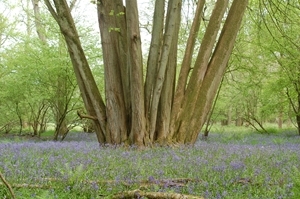The small-leaved lime tree (Tilia cordata)
 If you were asked the question - “what was the most common tree in the woods of lowland Britain before we started clearing the forests?” - what would be your answer? The oak? Ash maybe? For countless years most believed that the oak was the most common tree, but many now believe that the small-leaved lime reigned supreme. Let me explain why there has been this change in opinion.
If you were asked the question - “what was the most common tree in the woods of lowland Britain before we started clearing the forests?” - what would be your answer? The oak? Ash maybe? For countless years most believed that the oak was the most common tree, but many now believe that the small-leaved lime reigned supreme. Let me explain why there has been this change in opinion.
The tiny pollen grains produced by trees vary between species and can be readily identified. Many of these minute pollen grains became trapped in peat bogs, preserving them intact. From these records we know that small-leaved lime and oak existed in the British Isles about 10,000 years ago, soon after the last Ice Age. There were many, many more oak pollen grains than lime in these samples, so scientists deduced that obviously the oak was the most common tree back then.
The small-leaved lime, however, generates far less pollen than the oak because instead it produces masses of sweet-smelling yellow flowers in midsummer, which attract hordes of insects, especially bees, making the tree literally “hum” with pollinating activity. It is now recognised that even if a sample of peat produced 90% oak pollen, but only 10% lime pollen, this actually indicates woods dominated by lime, with only a few scattered oaks amongst them.
So why is this tree relatively uncommon nowadays if it was so abundant in the past? The answer is probably a combination of two main reasons. First, man started to let loose lots of grazing animals into the woods and they would make straight for the particularly tasty saplings of small-leaved limes, halting the regeneration of young trees to replace the old. Second, small-leaved limes need long hot summers to produce good quantities of seed and it may be that colder, wetter summers have reduced seed supplies. Ironically, climate change may reverse this decline, with predictions of hotter summers, and the tree is now also appearing on forestry recommended lists as a species to plant in the future!
The tree was also known in old English as linde, linden and lynd – so the town of Lyndhurst in the New Forest literally means “wooded hill growing with lime trees” as hurst means wooded hill. Small-leaved lime is also sometimes known as “the tree of a thousand uses”, as its wood has a tight, even grain that makes it ideal for carving and does not splinter when hit hard (hence Morris dancer’s sticks are often made of lime!). Grinling Gibbons, the famous wood carver who became master carver to King George I, loved to work with lime and most of his carvings in St. Paul’s Cathedral, Windsor Castle and Chatsworth House are made from this wood. Another huge benefit of lime wood is that it does not warp and so is perfect for making musical instruments and piano and organ keys.
If you strip the bark away from a small-leaved lime tree you will find underneath a fibrous layer called “bast” which was heavily sought after to make everything from baskets, ropes, nets, matting, cloth and even sandals.
So, although it may not be that common any more, the small-leaved lime is an important tree in the history of this country. Occasionally you may come across a giant tree growing in the forest (such as the one illustrated), its multitude of stems showing that it was once harvested for its wood. Some of these coppiced stools have been aged at 2,000 years old. Standing under one of these towering, majestic trees is a truly humbling experience, as you try to imagine the comings and goings of life that it must have witnessed during its long existence.
Peter Thompson
Advisory
Read more from Peter Thompson at the Fresh from the Field blog.

Download Peter Thompson's essential 26-page book, featuring beautiful photography and detailed profiles of Britain's wildlife
Download FREE >